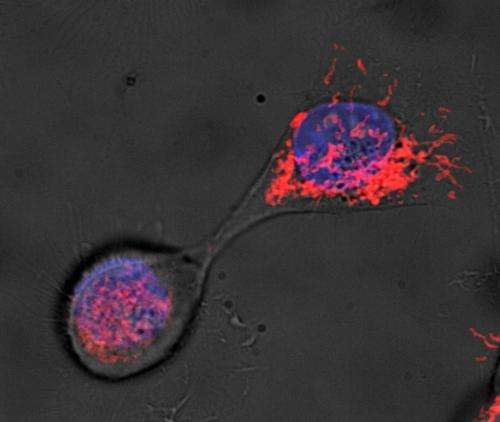Age-discrimination during cell division maintains the 'stem' in stem cells

A team of Whitehead Institute scientists has discovered that during division, stem cells distinguish between old and young mitochondria and allocate them disproportionately between daughter cells. As a result, the daughter cell destined to remain a stem cell receives predominantly young mitochondria, while the cell meant to differentiate into another cell type carries with it a higher compliment of the aged organelles.
This asymmetric apportioning of cellular contents may represent a mechanism through which stem cells prevent the accumulation of damage in their lineage over time.
"There is a fitness advantage to renewing your mitochondria," says Whitehead Member David Sabatini, whose lab reports on the phenomenon online this week in the journal Science. "Stem cells know this and have figured out a way to discard their older components."
Among the hallmarks of stem cells is so-called asymmetric cell division. Unlike their ordinary cellular counterparts, which divide symmetrically to create two cells with identical fates, stem cell division can produce one daughter cell that will remain a stem cell and another bound for further differentiation into another cell type. Scientists have observed that non-mammalian organisms are able to apportion damaged components asymmetrically during cell division, but it was unclear whether mammalian stem cells could behave similarly.
To answer this question, scientists in Sabatini's lab studied stem-like cells (SLCs) from cultures of immortalized human mammary epithelial cells. These SLCs were chosen because they express genes associated with the stem-cell state (referred to as stemness), are able to form structures known as mammospheres in culture. To track the destinations of subcellular components during cell division, the researchers, led by former postdoctoral scientist Pekka Katajisto, tagged the components—including lysosomes, mitochondria, Golgi apparatus, ribosomes, and chromatin—with a fluorescent protein that glows when hit by a pulse of ultraviolet light.
By tracing the movements of the glowing organelles, the researchers were able to demonstrate that while the normal epithelial cells distributed all of the tagged components symmetrically to daughter cells, the SLCs localized their older mitochondria distinctly and passed on the lion's share of them to the daughter cells headed for differentiation. The researchers ultimately found that the number of older mitochondria in those cells was roughly six times that in daughter cells whose fate was to remain as stem cells.
In a series of additional experiments, the scientists found that cells that inherited fewer old mitochondria during asymmetric division formed three times the number of mammospheres per 1000 cells than the daughter cells inheriting a greater proportion old mitochondria. This was an indication that cells with fewer of these old organelles were, by the mammosphere-forming criterion, more stem-like. Further, they discovered that chemically disrupting the cells' inherent mitochondrial quality-control mechanisms prevented asymmetric apportioning of young and old mitochondria and caused the loss of stem-like characteristics. Taken together, these results indicate that this disproportionate allocation of aged mitochondria during stem cell division is essential for maintaining stemness in the next generation.
"While we do not know how stem cells recognize the age of their mitochondria, forced symmetric apportioning of aged mitochondria resulted in loss of stemness in all of the daughter cells," says Katajisto, the first author of the Science paper who now runs a lab at the Institute of Biotechnology at University of Helsinki. "This suggests that the age-selective apportioning of old and potentially damaged organelles may be a way to fight stem cell exhaustion and aging."
Katajisto is now exploring whether this phenomenon occurs in other cell types beyond the human mammary epithelial SLCs examined here as well as in in vivo studies.
More information: "Asymmetric apportioning of aged mitochondria between daughter cells is required for stemness" Science, April 2, 2015 (online edition) www.sciencemag.org/lookup/doi/ … 1126/science.1260384
Journal information: Science
Provided by Whitehead Institute for Biomedical Research




















